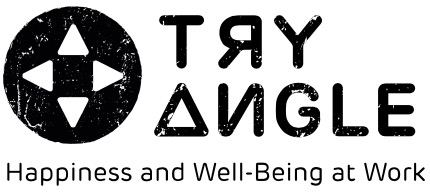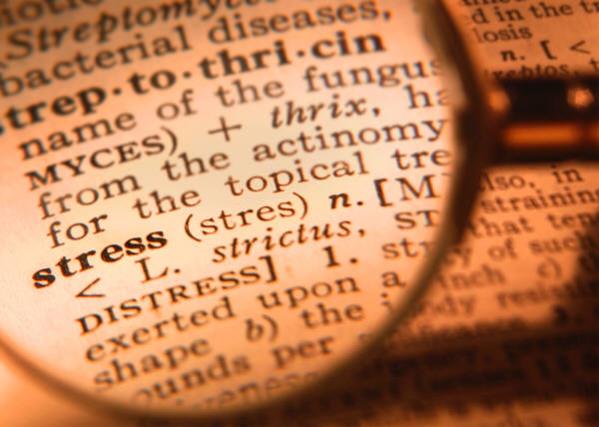Today, our brains process an average of one hundred and twenty thousand stimuli per day, compared to ‘only’ a good twenty-five thousand in the Middle Ages. Our technological solutions have grown exponentially, but our grey matter has not evolved with them. Our brains are simply not cut out to multitask all the time. After all, changing focus each time requires an enormous amount of energy.
Just as in the business world, when more work comes in for the same limited team, those team members come under pressure. And pressure will continue to build, up to the point where it becomes too heavy, resulting in … stress!
What exactly is stress?
Stress is a form of tension that occurs in the bodies of people, animals or plants as a reaction to external stimuli. It is followed by a certain pattern of physiological reactions; in other words: our body responds.
The stress reaction we see today in modern man, is identical to the stress reaction in primeval man when he felt threatened by a wild animal: his senses razor-sharp, he assesses how best to react. The right reaction (fighting, fleeing or stiffening/freezing) is of decisive importance in life-threatening situations.
Stress is healthy in origin. In fact: it is thanks to stress that the human race still exists today. It encourages us to take action at the right time.
The effect of stress on the nervous system
The various physical reactions that take place in our bodies when stress arises, are all in function of survival. For example:
- You grow pale because your fine blood vessels contract, so you wouldn’t waste blood in case of injury.
- Increased perspiration is necessary to avoid overheating while fighting or fleeing.
- Accelerated heart rate and muscle tension: blood and oxygen are pumped to your muscles so that your body is ready to react quickly.
Our reaction to stress is caused by our nervous system, which spreads stress hormonesin our bloodstream in the event of danger or threat. How does this work?
- The amygdala, a small almond-shaped particle in your brain, signals problems as soon as they arise.
- When that happens, the adrenal medulla secretes adrenaline and noradrenaline, causing
- Your heart rate to increase to pump blood to your muscles
- Your breathing to quicken to provide your muscles with extra oxygen
- Your digestion to stop
- Vital organs to switch to survival mode
- The adrenaline level quickly drops back to normal if you allow your body to recuperate after the stress incident.
Stress is intended for short peak moments. If your daily reality consists of stress peaks with breaks in between, then stress has a positive effect: it helps you to focus and be more productive. But there is a limit.
Every day, we must deal with an endless stream of triggers and stressors that evoke the fight or flight reflex in our brains. Think of discussions, work pressure, noise pollution in an open workspace, new e-mails popping up, … At a rate of thousands of stimuli per day, chronic stress may arise. And then things become dangerous.
Long-term stress
When stress hormones continue to accumulate in the body, a downward spiral develops, characterised by sleeping problems, fatigue, stomach complaints, a weakened immune system, muscle tension, irritation, concentration problems, …
Frequent or prolonged stressful situations cause a sustained increase in adrenaline levels. This then triggers the production of cortisol in the adrenal cortex.
Cortisol eliminates a number of functions of your immune system to save energy. It also raises your blood sugar level to provide you with the necessary fuel to cope with the long-term threat. Producing cortisol is particularly exhausting for your body. Moreover, a long-term increase in cortisol levels may cause:
- More inflammations in your body
- Brain fog, which leads to loss of concentration
- Burn-out
So, no wonder that stress has acquired a negative connotation.
We cannot avoid stimuli and stress situations, neither can we avoid our brains and bodies reacting to them. Fortunately, there are different measures you can take to reduce chronic stress. This can be done in several ways, two of which we will take a closer look at.
Change your thinking pattern
First of all, not all stress situations need to be negative. You can exert a great deal of influence by adopting a conscious positive attitude. Just as our thoughts can create additional stress situations, we can also do the opposite. This can be done by changing your thinking pattern.
It has been scientifically proven that stress can have a reinforcing effect, provided that you see it as a strengthening trait. If you interpret certain situations as ‘I find it exciting’ instead of ‘I’m really not up to this’, you can already make a difference. Think specifically about how that surging sense of excitement you experience, can help you focus better and react quicker and more appropriately. Just like a top athlete who is able to stretch that extra mile at the moment of truth.
Seeing stress as useful already creates a completely different biological reality!
Recuperate
Secondly, our body is not designed to be under long-term tension, even if you look at it in a positive way. Our new, technological reality is loaded with stimuli that are continually being fired at us. You can prevent this multitude of impulses from accumulating by letting your body and brain recuperate in time. Tryangle can tell you more about these coping mechanisms.
Try a different angle
The message is this: reverse the negative spiral and deal with your stress more consciously. With the right tools, techniques and coaching, you can bring out the best version of yourself and your colleagues. That’s a promise!
The problem of stress is one of the undercurrents that determine the current dynamics around well-being and happiness at work. Interested to learn more? Keep an eye on our blogs or order the book ‘Van Welvaart naar Werkgeluk’ (‘From Prosperity to Happiness at Work’).
Time to act? Click here to learn more about suitable workshops and training, aimed at employees and the business environment.





